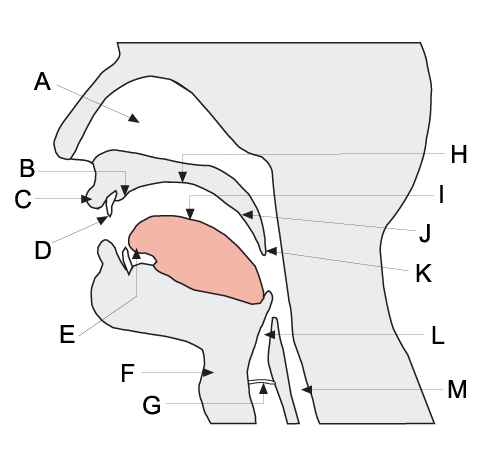|
Vocal Loading
Vocal loading is the stress inflicted on the speech organs when speaking for long periods. Background Of the working population, about 13% have professions where their voice is their primary tool. That includes professions such as teachers, sales personnel, actors and singers, and TV and radio reporters. Many of them, especially teachers, suffer from voice-related medical problems. In a larger scope, this involves millions of sick-leave days every year, for example, both in the US and the European Union. Still, research in vocal loading has often been treated as a minor subject. Voice organ Voiced speech is produced by air streaming from the lungs through the vocal cords, setting them into an oscillating movement. In every oscillation, the vocal folds are closed for a short period of time. When the folds reopen the pressure under the folds is released. These changes in pressure form the waves called (voiced) speech. Loading on tissue in vocal folds The fundamental frequency ... [...More Info...] [...Related Items...] OR: [Wikipedia] [Google] [Baidu] |
Speech Organ
The field of articulatory phonetics is a subfield of phonetics that studies articulation and ways that humans produce speech. Articulatory phoneticians explain how humans produce speech sounds via the interaction of different physiological structures. Generally, articulatory phonetics is concerned with the transformation of aerodynamic energy into acoustic energy. Aerodynamic energy refers to the airflow through the vocal tract. Its potential form is air pressure; its kinetic form is the actual dynamic airflow. Acoustic energy is variation in the air pressure that can be represented as sound waves, which are then perceived by the human auditory system as sound. Respiratory sounds can be produced by expelling air from the lungs. However, to vary the sound quality in a way useful for speaking, two speech organs normally move towards each other to contact each other to create an obstruction that shapes the air in a particular fashion. The point of maximum obstruction is called t ... [...More Info...] [...Related Items...] OR: [Wikipedia] [Google] [Baidu] |
Vocology
Vocology is the science and practice of vocal habilitation, or vocal training and therapy.Titze IR. (1996). What is vocology? Logopedics Phoniatrics Vocology, 21:5-6. Its concerns include the nature of speech and language pathology, the defects of the vocal tract ( laryngology), the remediation of speech therapy, and the voice training ( voice therapy) and voice pedagogy of song and speech for actors and public speakers. In its broadest sense, vocology is the study of voice, but as a professional discipline it has a narrower focus: the science and practice of voice habilitation, which includes evaluation, diagnosis, and intervention. History Vocology was invented (simultaneously, but independently) by Ingo Titze, and an otolaryngologist at Washington University, Prof. George Gates. Titze defines vocology as "the science and practice of voice habilitation, with a strong emphasis on habilitation". To habilitate means to “enable”, to “equip for”, to “capacitate”; i ... [...More Info...] [...Related Items...] OR: [Wikipedia] [Google] [Baidu] |
Human Voice
The human voice consists of sound made by a human being using the vocal tract, including talking, singing, laughing, crying, screaming, shouting, humming or yelling. The human voice frequency is specifically a part of human sound production in which the vocal folds (vocal cords) are the primary sound source. (Other sound production mechanisms produced from the same general area of the body involve the production of unvoiced consonants, clicks, whistling and whispering.) Generally speaking, the mechanism for generating the human voice can be subdivided into three parts; the lungs, the vocal folds within the larynx (voice box), and the articulators. The lungs, the "pump" must produce adequate airflow and air pressure to vibrate vocal folds. The vocal folds (vocal cords) then vibrate to use airflow from the lungs to create audible pulses that form the laryngeal sound source. The muscles of the larynx adjust the length and tension of the vocal folds to 'fine-tune' pitc ... [...More Info...] [...Related Items...] OR: [Wikipedia] [Google] [Baidu] |
Vocal Rest
Vocal rest or voice rest is the process of resting the vocal folds by not speaking and singing typically following viral infections that cause hoarseness in the voice, such as the common cold or influenza or more serious vocal disorders such as chorditis or laryngitis. Vocal rest is also recommended after surgery to removal of vocal fold lesions, such as vocal fold cysts. The purpose of vocal rest is to hasten recovery time. It is believed that vocal rest, along with rehydration, will significantly decrease recovery time after a cold. It is generally believed, however, that if one needs to communicate one should speak and not whisper. The reasons for this differ; some believe that whispering merely does not allow the voice to rest and may have a dehydrating effect, while others hold that whispering can cause additional stress to the larynx The larynx (), commonly called the voice box, is an organ in the top of the neck involved in breathing, producing sound and protecting th ... [...More Info...] [...Related Items...] OR: [Wikipedia] [Google] [Baidu] |

